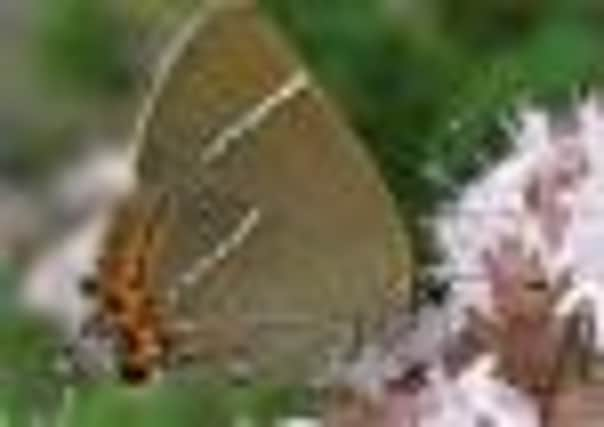Tree felling threatens habitat


An email drew my attention to this lonely bench. It sums up a sad story. A few days ago a mixture of wych elms, oaks and other trees towered up behind it, making it a pleasant sheltered place to rest a few moments on a warm summer’s afternoon.
That wych elm was the home of a colony of white-letter hairstreaks, one of Yorkshire’s rarer and extremely elusive butterflies.
Advertisement
Hide AdAdvertisement
Hide AdThe acres of oaks behind were even more important in holding the most active part of what is thought to be the largest colony of purple hairstreaks in the whole of Yorkshire, probably numbering several thousand individuals.
Hairstreaks are mainly tree-top butterflies, which means they are difficult to see and easy to overlook.
You need a lot of patience and a good pair of binoculars. They are mainly active in July and just occasionally, usually in the late afternoon, the odd individual might descend to ground level and take nectar from a flower.
But for most of the day they are hidden, grazing on leaves for aphid honeydew.
Advertisement
Hide AdAdvertisement
Hide AdThe purple hairstreak is a pale silvery grey in closed-wing view and looks very similar to a splash of sunlight on the waxy surface of an oak leaf.
If it opens its wings to show its overall purple sheen (as in the male) or its patches of purple on a darker background (as in the female) you realise that the purple colouring is ephemeral.
It changes according to the angle of light. It can shine deep purple one moment and become a dark shadow the next.
The white-letter hairstreak is altogether darker and never rests with wings open. Its name comes from a thin white line seen on the underwings which forms a rough W shape. Both hairstreaks are fairly small.
Advertisement
Hide AdAdvertisement
Hide AdUnusually for butterflies, you look for purple hairstreaks between about 5pm and dusk. They become very active on a warm July evening.
Males hold territories to tempt females to join them. They also chase off any other males.
As you gaze up, first you see nothing. Then suddenly a dozen or more may rise up and chase around a tree, their silvery grey underwings catching the light of the setting sun. It can be all over in seconds.
Then you wait again for a repeat performance of one of nature’s most fascinating action scenes.
Advertisement
Hide AdAdvertisement
Hide AdIt appears that the clear felling highlighted is part of a conservation project to rejuvenate these woods.
But what a pity no-one thought to contact Butterfly Conservation to ask their advice at the planning stage.
Hopefully, as both species are found on both sides of the road, the whole site will not be destroyed.
Newly-planted oaks will need some 15 to 20 years of growth before they are once again suitable to support the purple hairstreak, so older oaks will need to be retained to prevent the butterfly being wiped out.
Advertisement
Hide AdAdvertisement
Hide AdThe white-letter hairstreak will disappear unless wych elms are included in the planting.
Since 1995 Butterfly Conservation Yorkshire (the Yorkshire Branch of the national organisation) has been collecting data from every part of the county in order to provide information which contributes to our knowledge of both the national and local distributions of British butterflies.
Volunteers monitor dozens of sites, counting along fixed walks on a weekly basis, or observing a site for one particular species.
The group regularly receives requests for site and management information, and with both voluntary and full-time staff, actively helps in our National Parks and on Forestry Commission land.
Advertisement
Hide AdAdvertisement
Hide AdIn some cases it has been possible to help landowners get additional grant aid.
BC Yorkshire can be contacted via its website: www.yorkshirebutterflies.org.uk
My column now takes a break until next spring.